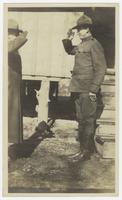Benjamin Lee Smith Papers
Pages
-

-
Photograph of Benjamin L. Smith
-
This photograph of Benjamin L. Smith is inscribed on the back "Startown Farm Life School, 1916-1917." The school was located in Catawba County, North Carolina, and Smith was approximately twenty-three years old at the time the photograph was taken.
-

-
Photograph of Benjamin L. Smith
-
This photograph of Benjamin L. Smith in uniform is inscribed "Camp Jackson, 1917-1918," and was taken while he served in the U.S. Army during World War I, from 1917 to 1919. While serving, he received the rank of captain.
-

-
Photograph of Benjamin L. Smith
-
This photographic portrait of Benjamin L. Smith was taken around 1955, by an unindentified photographer. Smith was Greensboro's Superintendent of School at this time.
-

-
Photograph of Benjamin L. Smith
-
This photographic portrait of Benjamin L. Smith was taken around 1953, by an unindentified photographer. Smith was Greensboro's Superintendent of School at this time.
-

-
Re: Desegregation
-
This handwritten note or essay appears to have been written around 1954 regarding Greensboro Public School Superintendent Benjamin L. Smith's response to theBrown v. Board of Education decision. The note is positive and praises Smith's actions. The author and date of the piece are unidentified.
-

-
Report of special committee on integration in our public school system
-
This January 25, 1956 report makes recommendations as to how member churches of the National Council on Churches should work to support school desegregation in their communities. The recommendations reaffirm and advance a 1955 resolution adopted by the National Council of Churches which states: "Now that the Supreme Court has spoken (regarding segregation in the public schools) we urge that churches as represented in the Council accept the decision of the Court as the law of the land and endeavor as fully as possible, in the spirit of Christ, to realize an integrated public school system."
-

-
Report of the superintendent to the Greensboro City Board of Education regarding Brown v. Board of Education
-
This report regarding the Brown v. Board of Education decision and the state's Pearsall Plan, was written by Greensboro school superintendent Benjamin L. Smith and submitted to the Greensboro City School Board of Education around 1956. Smith writes that he has completed lengthy research regarding the decision, and he has come the conclusion that "desegregation is an idea whose hour has arrived." He argues that compliance is inevitable and that time is needed to reorganize in preparation. The report gives two circumstances under which the board would be justified in asking for a declaratory decision, and provides recommendations for implementing desegregation.
-

-
Resolution authorizing the city superintendent of schools to make certain temporary assignments of children to schools
-
This resolution passed by the Greensboro City Board of Education on July 23, 1957 rescinds a May 21 resolution, and allows Superintendent Benjamin L. Smith to temporarily assign students to schools for the 1957-1958 school year if a child has not been assigned to a school or their place of residence has changed from the previous year. This resolution was among several passed by the Greensboro Board of Education to address how the city would desegregate its public schools in the wake of the Brown v. Board of Education decision and the state legislature's passage of the Pearsall Plan.
-

-
Resolution relating to the assignment of children not now in the Greensboro schools
-
This resolution passed by the Greensboro City Board of Education on May 21, 1957 allows students not previously assigned to a school by the board to receive a temporary assignment from Superintendent Benjamin L. Smith for the 1957-1958 school year. This resolution was among several passed by the Greensboro Board of Education to address how the city would desegregate its public schools in the wake of the Brown v. Board of Education decision and the state legislature's passage of the Pearsall Plan.
-

-
Resolution with respect to decision of the United States Supreme Court banning segregation in the public schools
-
This resolution passed by the Greensboro City Board of Education on May 18, 1954 states that the board will "instruct the Superintendent [Benjamin L. Smith] to study and report to the Board regarding ways and means for complying with the Court's decision." This resolution was among several passed by the Greensboro Board of Education to address how the city would desegregate its public schools in the wake of the Brown v. Board of Education decision.
-

-
Segregation and the Supreme Court
-
In this speech, the unidentified author, possibly Benjamin L. Smith, discusses the pending Supreme Court decision on Brown v. Board of Education in 1954. The writer briefly provides details for the five cases that makeup Brown, and provides the three possible outcomes of the case.
-

-
Separate and Equal Public Education is in the Interest...'
-
This clipping from the June 17, 1951 issue of the Greensboro Daily News is a transcript of a speech given by Edward Kidder Graham Jr. on the issue of segregation in schools. Graham was Chancellor of the University of North Carolina Woman's College at the time he gave the speech to the North Carolina Congress of Parents and Teachers in Winston-Salem<br><br>Graham begins his speech by discussing North Carolina's traditions, including courage, independence, idealism, progressiveness, practicality, and religious faith. He goes on to state that North Carolina is in a period of controversy over school segregation, and that citizens must accept both sides of the argument. He cites instances where the North Carolina Public School System has provided separate but equal educational facilities for blacks, and argues that the issue of segregation is focused on the separate status, not equality. His proposals for action in segregation include: meeting the issue head on; avoid emotional involvement in arguing the issue; concede dignity to those with differing opinions; improve schools for both blacks and whites; establish effective communication between all parties; and measure successes and failures through religious faith.
-

-
Speech by Benjamin L. Smith to the Greensboro Men's Civic Club
-
This typescript copy of a speech given by Benjamin L. Smith to the Greensboro Men's Civic Club discusses Smith's efforts for school desegregation, and requests for support of a upcoming bond referendum. Smith states that he wants to provide "equal educational opportunity to all the children of all the people."
-

-
Speech by Benjamin L. Smith to the Kiwanis Club
-
This is a transcript of a speech given by Greensboro school superintendent, Benjamin L. Smith, to the Kiwanis Club of Rutherfordton, North Carolina, at the celebration of their thirtieth anniversary in 1954. In the speech, Smith calls upon the Kiwanis to support the public school system during the time of adjustment after the Brown v. Board of Education decision, and argues in favor of desegregation. The typed transcript features handwritten marginal notes presumably by Smith.
-

-
Staff summary of desegregation in Greensboro, North Carolina
-
This six-page document from the U.S. Civil Rights Commission is a staff summary of desegregation in Greensboro, North Carolina, in 1959. Descriptions of Greensboro's demography, educational background, composition of the board of education, groups in support/opposition to desegregation, and the status of segregation in the community are included. In addition, the report contains summaries of Greensboro's initiation and implementation of school desegregation, and events aiding/hindering desegregation. The report was included in participant notebooks issued at the commission's 1959 National Conference of Public School Officials entitled "The Problems of Schools in Transition From the Educator's Viewpoint."
-

-
Statement by Benjamin L. Smith regarding Brown v. Board of Education
-
This one-page statement regarding the Brown v. Board of Education decision was drafted by Greensboro school superintendent Benjamin L. Smith around 1955. Smith says that the school desegregation process "calls for a degree of restraint on the part of the Negro race and an acceptance of concession on the part of the white race." The original purpose of the statement and its use is unknown.
-

-
Statement of Benjamin L. Smith before the U.S. Civil Rights Commission conference in Nashville
-
This transcript of a statement made by former Greensboro public school superintendent, Benjamin L. Smith, before the 1959 U.S. Civil Rights Commission conference in Nashville, Tennessee, describes Greensboro's efforts at desegregating its public school system.<br><br>In this statement, Smith explains that school desegregation has been generally accepted by the community. He offers an overview of the desegregation of Gillespie Elementary School and Greensboro Senior High in 1957, and recalls the resolution of compliance passed by the Greensboro School Board the day after the Brown v. Board of Education decision, and shares the details of a resolution adopted by the board in 1957. The reasons he feels desegregation in Greensboro was possible are: a liberal community, extraordinary school board, dedicated school personnel, favorable press, and an alert police force. He remarks on Greensboro's traditionally black universities, its integrated school board, integrated classes at the polio hospital and the Cerebral Palsy School, and the influencing presence of the Quaker population.<br><br>Smith offers to answer questions from the board. In response to a question of whether new black students were transferred in 1958, he says that there were not and that a child was denied admittance to Curry School by the Woman's College. When asked if there has been negative response, he recalls having a cross burned in his yard, bricks thrown through his window, and picketing at Gillespie. When asked if more schools would be desegregated, he says that no parents will be forced to send their children to schools they don't want to be at, and that some applications for reassignment were rejected for various reasons. He refers multiple times to the Caldwell Elementary-Pearson Street School court case that was pending at the time of this conference.
-

-
Statement to principals and supervisors
-
This August 23, 1957 policy statement was prepared by Superintendent Benjamin L. Smith for distribution to principals and supervisors in the Greensboro City School System. Smith clarifies the role of the superintendent in relation to the school board. He encourages school administrators to remain up-to-date on changes in education policy, and explains the current student assignment policy of the Greensboro School Board in the wake of the Brown v. Board of Education decision and the state legislature's passage of the Pearsall Plan. He addresses the recent enrollment of African American students at two previously all-white schools in the city, and commends the staffs of those schools for their efforts.
-

-
Story of desegregation in Greensboro, NC
-
This transcript of a statement made by Greensboro school Superintendent Benjamin L. Smith to the U.S. Civil Rights Commission in Nashville, Tennessee, on March 5, 1959, tells the history of school desegregation in Greensboro, North Carolina. Smith details the educational achievements of the six African American students enrolled at previously all-white schools in 1957. He discusses the resolution in support of desegregation passed by the Greensboro School Board the day after the Brown v. Board of Education decision, as well as the resolution passed by the board in 1957 for assigning students to schools according to the state's Pearsall Plan. Smith concludes his statement by explaining why he feels desegregation was a success in Greensboro.
Pages

